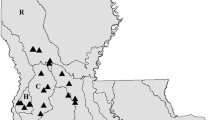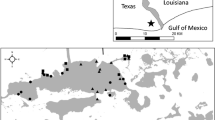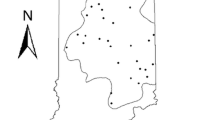Abstract
The use of techniques with low or inconsistent sampling efficiency may lead to erroneous estimates of abundance. Although an increase in sampling intensity can improve sampling efficiency and precision, its cost can limit a study’s spatial extent. A low-effort approach may be preferred for landscape-scale studies of fish distribution and abundance; however, this requires information on whether the low-effort sampling is vulnerable to habitat-mediated bias and imprecision of the estimator. To determine how habitat features affected sampling efficiency of juvenile coho salmon Oncorhynchus kisutch in headwater streams of the Little Susitna drainage, Alaska, we validated single-pass backpack electrofishing methods with closed population mark–recapture sampling. We found that habitat features, such as stream size and density of wood debris, had no measurable or consistent effect on sampling efficiency within the range of conditions present in these headwater systems, and single-pass catch explained 94.8 % of the observed variation in log-transformed mark–recapture estimates. This suggests that low-effort methods in headwater streams of the Little Susitna River can approximate actual fish numbers without accounting for habitat covariates that may influence sampling efficiency, and the advantage of sampling a greater spatial extent may sufficiently offset any concerns over low estimator precision.




Similar content being viewed by others
References
Reynolds JB (1996) Electrofishing. In: Murphy BR, Willis DW (eds) Fisheries techniques, 2nd edn. American Fisheries Society, Bethesda, pp 221–253
Dunham JB, Rosenberger AE, Thurow RF, Dolloff CA, Howell PJ (2009) Coldwater fish in wadeable streams. In: Bonar SA et al (eds) Standard method for sampling North American freshwater fishes. American Fisheries Society, Bethesda, pp 119–138
Kruse CG, Hubert WA, Rahel FJ (1998) Single-pass electrofishing predicts trout abundance in mountain streams with sparse habitat. N Am J Fish Manag 18:940–946
Peterson JT, Thurow RF, Guzevich JW (2004) An evaluation of multipass electrofishing for estimating the abundance of stream-dwelling salmonids. T of Am Fish Soc 133:462–475
Thompson PD, Rahel FJ (1998) Evaluation of artificial barriers in small Rocky Mountain streams for preventing the upstream movement of Brook Trout. N Am J Fish Manag 18:206–210
Rosenberger AE, Dunham JB (2005) Validation of abundance estimates from mark–recapture and removal techniques for rainbow trout captured by electrofishing in small streams. N Am J Fish Manag 25:1395–1410
Dolloff CA, Hankin DG, Reeves GH (1993) Basinwide estimation of habitat and fish populations in streams. U.S. Department of Agriculture, Forest Service, Southeastern Forest Experiment Station, SE-83, Asheville
Torgersen CE, Baxter CV, Li HW, McIntosh BA (2006) Landscape influences on longitudinal patterns of river fishes: spatially continuous analysis of fish-habitat relationships. Am Fish Symp 48:473–492
Fausch KD, Torgerson CE, Baxter CV, Li HW (2002) Landscapes to riverscapes: bridging the gap between research and conservation of stream fishes. Bioscience 52:1–16
Gresswell RE, Torgersen CE, Bateman DS, Guy TJ, Hendricks SR, Wofford JEB (2006) A spatially explicit approach for evaluating relationships among coastal cutthroat trout, habitat, and disturbance in small Oregon streams. Am Fish Symp 48:457–471
Johnson J, Weiss E (2007) Catalog of waters important for spawning, rearing, or migration of anadromous fishes—Southcentral Region, Effective 1 June 2007. Alaska Department of Fish and Game, Special Publication No. 07-05, Anchorage
Cho GK, Heath DD (2000) Comparison of tricaine methanesulphonate (MS222) and clove oil anaesthesia effects on the physiology of juvenile chinook salmon Oncorhynchus tshawytscha (Walbaum). Aquac Res 31:537–546
Kennedy BM, Gale WL, Ostrand KG (2007) Evaluation of clove oil concentrations for use as an anesthetic during field processing and passive integrated transponder implantation of juvenile steelhead. Northwest Sci 81:147–154
Gaines PE, Martin CD (2004) Feasibility of dual-marking age-0 Chinook salmon for mark–recapture studies. N Am J Fish Manag 24:1456–1459
Otis DL, Burnham KP, White GC, Anderson DR (1978) Statistical inference from capture data on closed animal populations. Wildl Monogr 62:3–135
Seber GAF (1982) The estimation of animal abundance and related parameters. Edward Arnold, London
Peterson NP, Cederholm CJ (1984) A comparison of the removal and mark–recapture methods of population estimation for juvenile coho salmon in a small stream. N Am J Fish Manag 4:99–102
Temple GM, Pearsons TN (2006) Evaluation of the recovery period in mark–recapture population estimates of rainbow trout in small streams. N Am J Fish Manag 26:941–948
Bisson PA, Nielsen JL, Palmason RA, Grove LE (1982) A system of naming habitat types in small streams, with examples of habitat utilization by salmonids during low streamflow. In: Armantrout NB (ed) Acquisition and utilization of aquatic habitat inventory information. American Fisheries Society, Western Division, Bethesda, pp 62–73
Helm WT (ed) (1985) Aquatic habitat inventory: glossary of stream habitat terms. American Fisheries Society, Western Division, Habitat Inventory Committee, Logan
Hawkins CP, Kershner JL, Bisson PA, Bryant MD, Decker LM, Gregory SV, McCullough DA, Overton CK, Reeves GH, Steedman RJ, Young MK (1993) A hierarchical approach to classifying stream habitat features. Fisheries 18:3–12
Wentworth CK (1922) A scale of grade and class terms for clastic sediments. J Geol 30:377–392
Cummins KW (1962) An evaluation of some techniques for the collection and analysis of benthic samples with special emphasis on lotic waters. Am Midl Nat 67:477–504
Flebbe PA (1999) Trout use of woody debris and habitat in Wine Spring Creek, North Carolina. For Ecol Manag 114:367–376
Chapman DG (1948) A mathematical study of confidence limits of salmon populations calculated from sample tag ratios. Int Pac Salmon Fish Comm Bull 2(69):85
Burnham KP, Anderson DR (2002) Model selection and inference: an information-theoretic approach. Springer, New York
Akaike H (1973) Information theory and an extension of the maximum likelihood principle. In: Petrov BN, Csaki F (eds) Second international symposium on information theory. Akademiai Kiado, Budapest, pp 267–281
R Development Core Team (2011) R: a language and environment for statistical computing. R Foundation for Statistical Computing, Vienna. ISBN 3-900051-07-0, URL http://www.R-project.org/. Accessed Aug 2011
Zeileis A, Hothorn T (2002) Diagnostic checking in regression relationships. R News 2:7–10
Fox J, Weisberg S (2011) An R companion to applied regression, second edition. Sage, Thousand Oak. http://socserv.socsci.mcmaster.ca/jfox/Books/Companion. Accessed Aug 2011
Harrell FE Jr, Dupont C, with contributions from many other users (2010) Hmisc: Harrell miscellaneous. R package version 3.8–3
Sprugel DG (1983) Correcting for bias in log-transformed allometric equations. Ecology 64:209–210
Riley SC, Fausch KD (1992) Underestimation of trout population size by maximum-likelihood removal estimates in small streams. N Am J Fish Manag 12:768–776
Kennedy GJA, Strange CD (1981) Efficiency of electric fishing for salmonids in relation to river width. Fish Manag 12:55–60
Rodgers JD, Solazzi MF, Johnson SL, Buckman MA (1992) Comparison of three techniques to estimate juvenile coho salmon populations in small streams. N Am J Fish Manag 12:79–86
Frissell CA, Liss WJ, Warren CE, Hurley MD (1986) A hierarchical framework for stream habitat classification—viewing streams in a watershed context. Environ Manag 10:199–214
Wiens JA (2002) Riverine landscapes: taking landscape ecology into the water. Freshw Biol 47:501–515
Acknowledgments
This project received Institutional Animal Care and Use Committee (IACUC) approval under IRBNet ID 157737-5. We thank Phillip Taylor, Casey Smith, Parke Loyd, Danielle McClain, Sydney Clark, Sarah Laske, Jonathon Gerken, and Doug McBride for assistance with field data collection. We also thank the many landowners throughout the study region who granted access across their property to our study sites, most notably Scott and Linda Schwald. We also thank Justin Carney and Nicholas Smith for their assistance in data analyses. We thank Sarah Laske and Trevor Haynes for their assistance and helpful comments on previous versions of this manuscript. Funding for this work was provided by the U.S. Fish and Wildlife Service, Anchorage Field Office. Use of trade names does not imply endorsement of any product or service by the U.S. Government.
Author information
Authors and Affiliations
Corresponding author
Rights and permissions
About this article
Cite this article
Foley, K., Rosenberger, A. & Mueter, F. Effectiveness of single-pass backpack electrofishing to estimate juvenile coho salmon abundance in Alaskan headwater streams. Fish Sci 81, 601–610 (2015). https://doi.org/10.1007/s12562-015-0888-1
Received:
Accepted:
Published:
Issue Date:
DOI: https://doi.org/10.1007/s12562-015-0888-1




